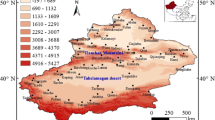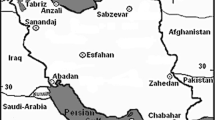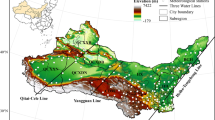Abstract
Reference crop evapotranspiration (ET 0 ) is a key parameter to calculate crop water requirements. In the paper, ET 0 during 1960–2005 was calculated with FAO-56 PM in eastern agricultural areas of Qinghai, China. Then the sensitivity coefficients of ET 0 to meteorological variables were estimated through the nondimensional partial derivative in FAO-56 PM. Results show that the mean annual ET 0 of the whole area is 904 mm, and ET 0 portrays a very significant decrease during the 46 years. In spatial, ET 0 decreases from southeast to northwest, firstly increases then decreases from southwest to northeast. Through sensitivity analysis, in spring the most sensitive variable is relative humidity, while in summer is temperature. The temperature, sunshine duration and wind speed sensitivity coefficients (S(TA), S(n), S(u)) are higher in middle areas as opposed to surrounding areas, while the relative humidity sensitivity coefficient (S(RH)) has an opposite distribution rule.
Similar content being viewed by others
References
Allen RG, Pereira LS, Raes D, et al. (1998) Crop evapotranspiration guidelines for computing crop water requirements. In: FAO Irrigation and Drainage Paper 56. United Nations Food and Agriculture Organization, Rome, Italy. pp. 3–15.
Beven K (1979) A sensitivity analysis of the Penman-Monteith actual evapotranspiration estimates. Journal of Hydrology 44:169–190.
Burn DH, Hesch NM (2007) Trends in evaporation for the Canadian Prairies. Journal of Hydrology 336: 61–73.
Chen SB, Liu YF, Axel TM (2006) Climatic change on the Tibetan Plateau: potential evapotranspiration trend from 1961–2006. Climatic Change 76: 291–319.
Gao G, Chen DL, Xu CY, et al. (2007) Trend of estimated actual evapotranspiration over China during 1960–2002. Journal of Geophysical Research 112(D11). doi:10.1029/2006JD008010
Gong LB, Xu CY, Chen DL, et al. (2006) Sensitivity of the Penman-Monteith reference evapotranspiration to key climatic variables in the Changjiang (Yangtze River) basin. Journal of Hydrology 329: 620–629.
Goyal PK (2004) Sensitivity of evapotranspiration to global warming. Agricultural Water Management 69: 1–11.
Hamby DM (1994) A review of techniques for parameter sensitivity analysis of environmental models. Environmental Monitoring and Assessment 32:135–154.
Hargreaves GH (1974) Estimation of potential and crop evapotranspiration. Transactions of the ASAE 17(4):701–704.
Hargreaves GH (1994) Defining and using reference evapotranspiration. Journal of Irrigation and Drainage Engineering-ASCE 120(6):1132–1139.
Hupet F, Vanclooster M (2001) Effect of the sampling frequency of meteorological variables on the estimation of the reference evapotranspiration. Journal of Hydrology 243:192–204.
Irmak S, Payero JO, Martin DL, et al. (2006) Sensitivity analyses and sensitivity coefficients of standardized daily ASCE-Penman-Monteith equation. Journal of Irrigation and Drainage Engineering 132: 564–578.
IPCC (2007) Climate Change 2007: The Physical Science Basis, Contribution of Working Group I to the Fourth Assessment Report of the Intergovernmental Panel on Climate Change, Solomon S, Qin D, Manning M, Marquis M, Averyt K, Tignor M, Miller H, Chen Z (eds). Cambridge University Press, Cambridge.
Jhajharia D, Shrivastava SK, Sarkar D, et al. (2009) Temporal characteristics of pan evaporation trends under the humid conditions of northeast India. Agricultural and Forest Meteorology 149:763–770.
Liu BH, Xu M, Henderson M, et al. (2004) A spatial analysis of pan evaporation trends in China, 1955–2000. Journal of Geophysical Research 109: D15102.
Liang LQ, Li LJ, Zhang L (2008) Sensitivity analysis of reference crop evaporation during growing season in Song-Nen plain west. Agricultural Engineering 24(5): 1–5. (In Chinese)
Lenhart T, Eckhardt K, Fohrer N, et al. (2002) Comparison of two different approaches of sensitivity analysis. Physics and Chemistry of the Earth 27: 645–654.
Mckenney MS, Rosenberg NJ (1993) Sensitivity of some potential evapotranspiration estimation methods to climate change. Agricultural and Forest Meteorology 64: 8–10.
Morris MD (1991) Factorial sampling plans for preliminary computational experiments. Technometrics 33: 161–174.
Penman HL (1948) Natural evaporation from open water, bare soil and grass. A Proceedings of the Royal Society of London Series A 193. pp 454–465.
Penman HL (1963) Vegetation and Hydrology. Commonwealth Bureau of Soils, Technical Communication. p 53.
Priestley CHB, Taylor RJ (1972) On the assessment of the surface of the heat flux and evaporation using large scale parameters. Monthly Weather Review 100(2): 81–92.
Rana G, Katerji N (1998) A measurement based sensitivity analysis of the Penman-Monteith actual evapotranspiration model for crops of different height and in contrasting water status. Theoretical and Applied Climatology l60: 141–149.
Saltelli A, Chan K, Scott EM (2000) Sensitivity analysis. Wiley, NewYork.
Tamm T (2002) Effect of meteorological conditions and water management on hydrological processes in agricultural fields: parameterization and modeling of Estonian case studies. Department of Civil and Environmental Engineering, Helsinki University of Technology, Finland. pp.194
Yang GY, Wang ZS, Wang H, et al. (2009) Potential evapotranspiration evolution rule and its sensitivity analysis in Haihe River basin. Advances in Water Science 20(3): 409–415. (In Chinese)
Zeng LH, Song KS, Zhang B (2010) Sensitive analysis on reference evapotranspiration to key meteorological factors in northeast China. Chinese Journal of Agrometeorology 31(1): 11–18. (In Chinese)
Zhang GS (1997) Analyzing the spring drought in agriculture area in Qinghai province a hazard countermeasures. Earthquake Research in Plateau 9(2): 69–73.
Zhao HH, GUO LY, Xu NL (2007) The change characteristics of the evaporation of Gonghe basin in recent 40 years. Qinghai Science and Technology 6:23–25. (In Chinese)
Author information
Authors and Affiliations
Corresponding author
Rights and permissions
About this article
Cite this article
Zhao, L., Liang, C., Cui, N. et al. Temporal and spatial variations of ET o and sensitivity coefficients in spring-summer in eastern agricultural areas of Qinghai, China. J. Mt. Sci. 9, 817–826 (2012). https://doi.org/10.1007/s11629-012-2343-4
Received:
Accepted:
Published:
Issue Date:
DOI: https://doi.org/10.1007/s11629-012-2343-4




